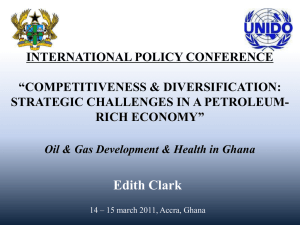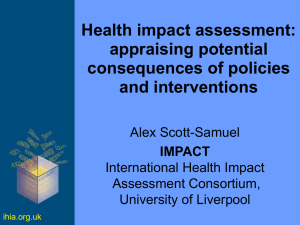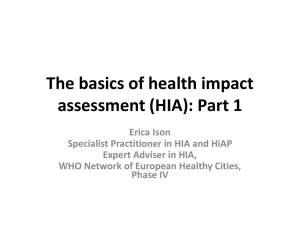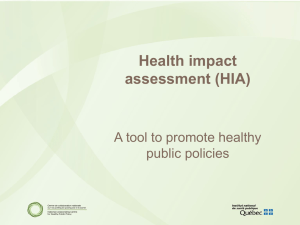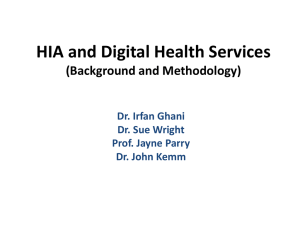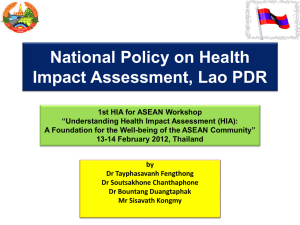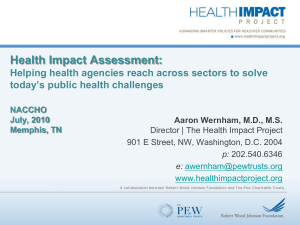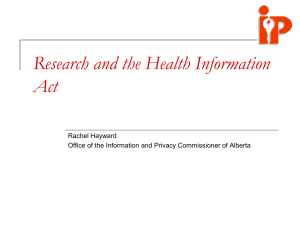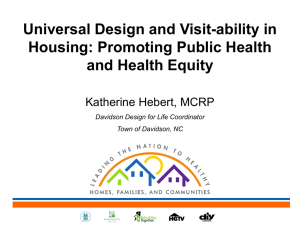Part 2 - East End Quality of Life Initiative
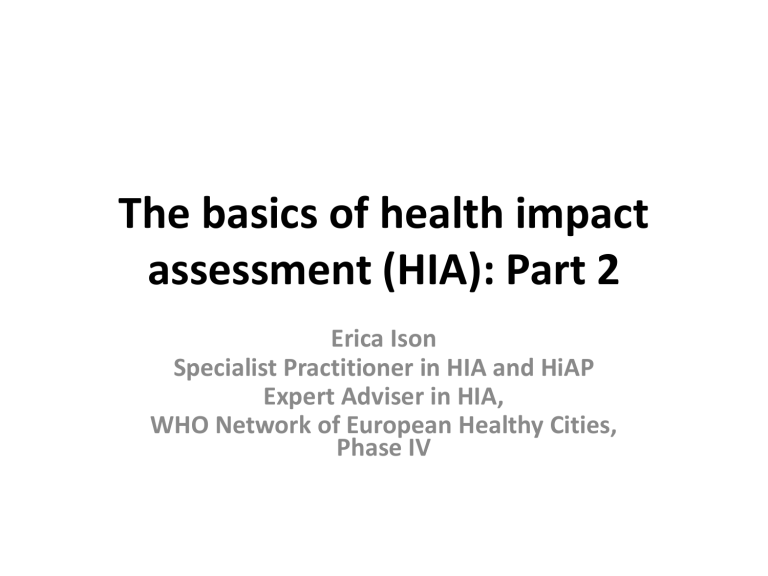
The basics of health impact assessment (HIA): Part 2
Erica Ison
Specialist Practitioner in HIA and HiAP
Expert Adviser in HIA,
WHO Network of European Healthy Cities,
Phase IV
Commission on the Social Determinants of Health
“ The inequities in how society is organized mean that the freedom to lead a flourishing life and to enjoy good health is unequally distributed between and within societies. This inequity is seen in the conditions of early childhood, schooling, the nature of employment and working conditions, the physical form of the built environment, and the quality of the natural environment in which they reside.
Depending on the nature of these environments, different groups will have different experiences of material conditions, psychosocial support, and behavioural options which make them more or less vulnerable to poor health.
Social stratification likewise determines differential access to and utilization of health care, with consequences for the inequitable promotion of health and well-being, disease prevention, and illness recovery and survival.”
Commission on the Social Determinants of Health
Overarching recommendations
• Improve daily living conditions, i.e. the circumstances in which people grow, live and age
• Tackle the inequitable distribution of power, money and resources – i.e. the structural drivers of the conditions of daily life – globally, nationally locally
• Measure and understand the problem and assess the impact of action – expand knowledge base, develop a workforce trained in social determinants of health, raise public awareness and evaluate action
Stage of HIA
Screening
Scoping
Appraisal
Reporting
Supporting decision-makers
Monitoring and evaluation
Classic process of HIA
Key questions to answer
Do we undertake an HIA on this proposal or not?
What are the boundaries for the HIA study? What are the management arrangements? What are the overall governance and accountability arrangements?
What are the proposal’s effects on health, for the whole population and for vulnerable groups? How can we achieve health gain through health protection, health improvement and reducing health inequalities?
How do we present the information about health impacts, and suggestions to address those impacts, in an ethically responsible way that is useful to and usable by decision-makers?
How do we support decision-makers to understand the HIA results in relation to other information about the proposal?
Process evaluation: Did the HIA process go well? Could it be improved? Effectiveness evaluation: What effect did the HIA have on the proposal? Outcome evaluation: What effect did the amended proposal have on health?
Stage of HIA
Screening – potential exit point
Scoping
Appraisal
Reporting
Supporting decision-makers
Monitoring and evaluation
Classic process of HIA
Tips
Use a screening tool appropriate to your locality and/or population; if there is no screening tool, use an agreed set of criteria
Use a checklist to ensure that all aspects of the HIA study and its governance and accountability are covered
Use an appraisal tool that includes the relevant determinants of health; identify methods that are appropriate to the timescale and budget available for the particular HIA
Use all types of information as equal but being aware that they reveal different facets of the issues and the ways to address them
Be sensitive to the type of report likely to support decisionmakers, without compromising the ethical treatment of the HIA’s findings
Conduct a process evaluation, preferably using a pre-agreed set of criteria, and an effectiveness evaluation – identify not only which
HIA suggestions were accepted but also which were implemented
HIA: levels or depths of appraisal
• Rapid – using the best available information, i.e. no “new” information is collected
• Comprehensive – primary research is conducted, i.e. “new” information is generated
Methods supporting appraisal
Undertaken by assessor(s)
• Literature review
• Review of HIA casestudies
• Profiling (population or individual communities)
• Desk-top appraisal
Undertaken with stakeholders
• Interactive: stakeholder workshops, focus groups, Delphi exercises, citizen’s juries
• Non-interactive: surveys (postal or face to face), interviews
HIA: What are the hallmarks?
•
Specificity
•
Enhancement as well as mitigation
•
Flexibility
•
Adaptability
Basic Tasks in HIA
• Screening the proposal
• Proposal analysis – what are the deliverables of the proposal?
• Identifying a governance and accountability framework for the
HIA
• Setting the boundaries for the study
• Setting the management arrangements for the HIA
• Profiling the community/population using routine and nonroutine data
• Review of published literature – “evidence base”
• Review of HIA case-studies
• Identification of potential impacts on health
• Identification of ways to change the proposal and/or its implementation based on the potential health impacts
• Writing a report of the results of appraisal
• Presenting the results to decision-makers responsible for the proposal
• Process evaluation
• Effectiveness (impact) evaluation
HIA of London’s Mayoral Strategies
• Previous Mayor of London made a political commitment to conducting HIA on all major mayoral strategies
• HIAs were undertaken by the London Health
Commission, an independent body, on behalf of
Mayor
• London Health Commission submitted HIA results to:
– Mayor;
– Greater London Assembly;
– team responsible for the strategy being assessed
London’s Mayoral Strategies
Transport
Economic development
Spatial development
Waste management
Noise
Energy
Biodiversity
Air quality
Culture
Older people
Process for HIA on London’s Mayoral Strategies
Scoping main topic areas of the strategy for the HIA to focus on
Literature review of potential impacts on health and effective interventions relating to the strategy
Rapid appraisal techniques used:
HIA stakeholder workshop before public consultation period
Stakeholders from the private, public and voluntary sectors were invited
No members of the public were included
Reporting the results
HIA on London’s Mayoral Strategies
Screening
Scoping
Appraisal
Reporting & Supporting decision-makers
All major strategies were subject to HIA
Main topics in strategy identified
Rapid literature review
Stakeholder workshop
Mayor, Greater London
Assembly & relevant strategy team given results
Monitoring & evaluation Process evaluation
Impact evaluation
HIA on London’s Mayoral Strategies
Questions for the stakeholder workshop on Noise Strategy
What parts of the strategy need to be kept on the basis of the impacts on people’s health and wellbeing? How can we increase those positive effects?
What parts of the strategy need to be changed because of their impacts on health and well-being?
How can we change the proposal to reduce/avoid those negative effects?
What could be added to the strategy to promote health and well-being?
Evaluation of HIA on London’s Mayoral
Strategies
“The HIAs have raised awareness of the social model of health and public health amongst those whose primary roles are not health related … Most importantly
[they] have influenced strategy.”
Opinion Leader Research, 2002
HIA of the Redevelopment &
Regeneration of the Lower Shankill
Background
• The Lower Shankill is a protestant housing estate in the centre of Belfast
• Dominated by several protestant paramilitary groups during the 30 years of the “Troubles”, including one of the most violent and notorious led by “Mad Dog Adair”
• Feuding among the paramilitaries in the summers of 2000 and 2001 resulted in 7 men being murdered, families were burnt out of their homes and more than 350 people were forced to leave the estate
HIA of the Redevelopment &
Regeneration of the Lower Shankill
Conditions on the estate
• Estate managed by the Northern Ireland Housing
Executive (NIHE)
• About 500 houses built at different times
• Large central open space infested with rats
• Many voids where empty houses were knocked down (policy during the “Troubles”)
• Road infrastructure poor and designed to enable the British Army to apprehend paramilitaries and prevent get-aways
HIA of the Redevelopment &
Regeneration of the Lower Shankill
Community profile for the HIA
People on the Lower Shankill are:
• Living in the 2 nd most deprived community in
Northern Ireland
• Experiencing multiple deprivation: poor access to services, unemployment, poor-quality environment, low educational attainment, and high levels of crime
• Suffering from severe health and other inequalities, some of which are a result of the “Troubles” and the later “Shankill feuds”
HIA of the Redevelopment & Regeneration of the Lower Shankill
• Based on 11 options in the Economic Appraisal, from minor refurbishment to complete redevelopment
• Commissioned by NIHE; project managed by Belfast
Healthy Cities
• Steering Group of partner organisations, including local government, health, voluntary sector & community representatives
• HIA project plan approved by the Steering Group
• Training in HIA given to community members and representatives from community organisations, who helped to compile the community profile
HIA of the Redevelopment & Regeneration of the Lower Shankill
Rapid appraisal methods
• Stakeholder workshop
• Open event at the local school
• Focus groups with the local women’s group, the old people’s home and with the ex-political prisoners
• Desk-top appraisal by HIA Assessor
Suggestions from all stakeholders and the HIA Assessor were based on the impacts identified and presented to NIHE
In addition, there was a poster competition for the schoolchildren (prize was a bicycle), and the children also made maps, models and posters for the open event
HIA of the Redevelopment & Regeneration of the Lower Shankill
Community responses during the HIA
• People said that the “heart had been ripped out of the estate”, and they felt “abandoned” by organisations in the public sector
• They wanted redevelopment and a better environment but not complete demolition of the estate because of the need for decanting (option 11), and most people did not want the estate taken over by private housing
• They thought redevelopment would give the estate a better image and reputation, which it badly needed
• They also wanted people who had left the estate to be able to return
Steering Group discussions
• Affordability of housing is key to the Shankill redevelopment (and to
Belfast as a whole)
• It is important to recognise the cultural needs of this protestant community
Which of the 11 options is best for health and well-being?
Options 1 & 2 Will not redress either the causes or effects of multiple deprivation on health
Options 3, 4 & 5 Offer little to social residents apart from small environmental improvements, but do increase the availability of social housing
Options 6, 8 & 10 Offer improved housing and environmental conditions for social residents – good for health – and increase availability of social housing
Option 7 Offers improved housing and environmental conditions for social residents – good for health – but increases mixed tenure with displacement of 20-30 social households
Which of the 11 options is best for
Option 9
health and well-being?
Large increase in private housing and major environmental improvements – gentrification, with displacement of ~100 social households
Option 11 Complete demolition of estate, requiring decanting of ~500 social households, which could mean displacement for some; mixed tenure with almost half the estate private housing, a reduction in availability of social housing and a new built environment; potential for gentrification
Which of the 11 options is worst for health and well-being?
• For the people living on the Lower Shankill, option
9, with the displacement of ~100 social households, would have serious harmful impacts on mental health and well-being, especially given the community’s previous history of displacement arising from conflict and violence
• Option 9 would also damage community cohesion, affecting family cohesion, social contact and the availability of social support (practical, emotional and technical), worsening their already poor health status
Which option gets chosen?
The decision also depends on political priorities
Renewal Do you want physical or social renewal?
Community support and cohesion
Do you want to support the existing community or provide housing for new residents with the potential for gentrification?
Supply of tenure Do you want to increase the availability of social housing or of private sector housing?
In option 9, the supply of social housing would be decreased with the displacement of social households
Mix of tenures What balance do you want of social housing to owner-occupier housing?
HIA: Benefits for stakeholder organisations
• Demonstrating a commitment to health and wellbeing of local people
• Health as an added value for organisations not in the health sector
• Potential for organisational development and learning
• Potential to improve partnership working among agencies and among sectors
• Potential to shift from services that solve problems to services that prevent problems arising
HIA: Benefits for the community
Greater involvement in policy- and decision-making
Potential to extend the democratic process, especially to groups in society who feel excluded
Skills development and capacity building
Potential to contribute to increasing social capital
Potential to reduce sources of inequality and disadvantage
Planning and design of services that better meet the needs of the local community
